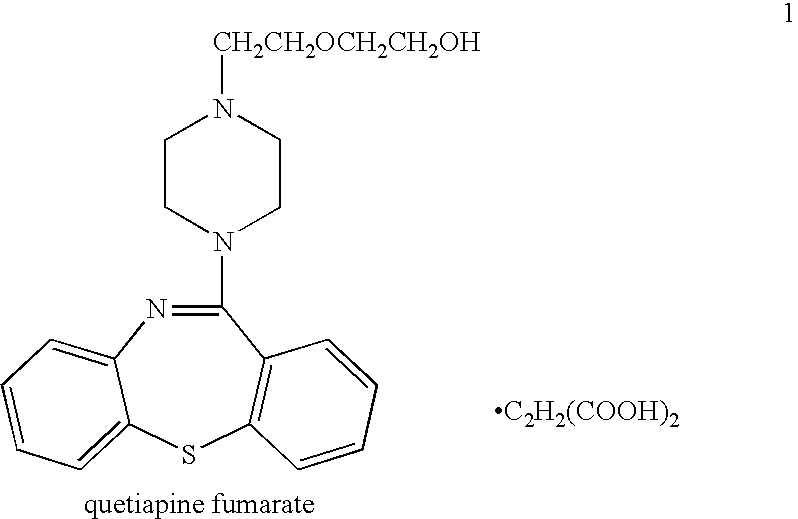Processes for preparing quetiapine and salts thereof
a technology which is applied in the field of quetiapine and salts thereof, can solve the problems of inconvenient unit operation, high cost, and inability to advantageously use industrial large-scale production, and achieve the effects of improving the efficiency of industrial production and reducing the cost of production
- Summary
- Abstract
- Description
- Claims
- Application Information
AI Technical Summary
Benefits of technology
Problems solved by technology
Method used
Image
Examples
example 1
[0123] A 250 ml three-necked round-bottom flask equipped with a mechanical stirrer, nitrogen inlet and a Dean-Stark apparatus was charged with toluene (75 ml), which was dried by azeotropic distillation. Dry DMF was added (3.7 ml, 0.048 mol) and the reaction mixture was cooled by ice-water bath. Oxalyl chloride was added drop-wise (4.24 ml, 0.048 mol) followed by adding dibenzo[b,f][1,4]thiazepine-11(10-H)-one in one portion (10 g, 0.044 mol) and the reaction mixture was heated to reflux for about 21 hours. The reaction mixture was cooled and the solvent was removed by rotary evaporator. The residue was dissolved in dichloromethane and washed with water. The layers were separated and activated charcoal was added to the organic layer containing the imino chloride. The suspension thus obtained was stirred for at least 15 minutes at elevated temperature (between 90° C. and 100° C.) and then hot-filtered. The filter was rinsed with warm dichloromethane. The filtrate was dried over magne...
example 2
[0124] A 1000 ml reaction vessel equipped with a magnetic stirrer and with a reflux condenser was charged with toluene (110 ml) and water (21 ml) and the solution was stirred. 1-(2-hydroxyethoxy)ethylpiperazine (27 g, 0.155 mol) and additional volume of toluene (100 ml) were added. Finally, 11-chloro-dibenzo[b,f][1,4]-thiazepine (35 g, 0.142 mol) and potassium carbonate (21 g, 0.152 mol) were added and the two-phase reaction mixture was heated to reflux. After about 20 hours the reaction mixture was cooled to 80° C. Water was added (190 ml) and the reaction mixture was cooled to 25° C. and stirred for 30 minutes. The mixture was filtered and the isolated solid was washed with toluene (35 ml). The two layers of the filtrate were separated. The organic phase was washed with water (210 ml). The combined aqueous layers were washed with toluene (105 ml). The organic layers, containing the quetiapine free base, were combined and activated charcoal was added and the suspension thus obtaine...
example 3
[0125] A 250 ml reaction vessel equipped with a magnetic stirrer and a reflux condenser was charged with toluene (30 ml). 1-(2-hydroxyethoxy)ethylpiperazine (7.8 g, 44.8 mmol), potassium carbonate (5.6 g, 40.6 mmol) and 11-chloro-dibenzo[b,f][1,4]-thiazepine (10 g, 40.8 mmol) were added. The mixture was heated to reflux for 6 hours. The mixture was cooled to 25° C. and washed twice with water (total volume: 90 ml). The organic layers were combined and activated charcoal was added to the combined organic layers containing the quetiapine free base. The suspension thus obtained was stirred for at least 15 minutes at elevated temperature (between 90° C. and 100° C.) and then hot-filtered. The filter was rinsed with warm toluene (50 ml). The filtrate and washings were combined, dried over magnesium sulfate and the solvent was removed by rotary evaporator to yield a yellow-colored oil. The oil was dissolved in ethanol (70 ml) and fumaric acid was added (2.4 g, 20.7 mmol) and the mixture w...
PUM
| Property | Measurement | Unit |
|---|---|---|
| temperature | aaaaa | aaaaa |
| temperature | aaaaa | aaaaa |
| time | aaaaa | aaaaa |
Abstract
Description
Claims
Application Information
 Login to View More
Login to View More - R&D
- Intellectual Property
- Life Sciences
- Materials
- Tech Scout
- Unparalleled Data Quality
- Higher Quality Content
- 60% Fewer Hallucinations
Browse by: Latest US Patents, China's latest patents, Technical Efficacy Thesaurus, Application Domain, Technology Topic, Popular Technical Reports.
© 2025 PatSnap. All rights reserved.Legal|Privacy policy|Modern Slavery Act Transparency Statement|Sitemap|About US| Contact US: help@patsnap.com



